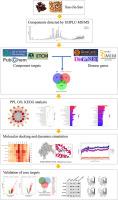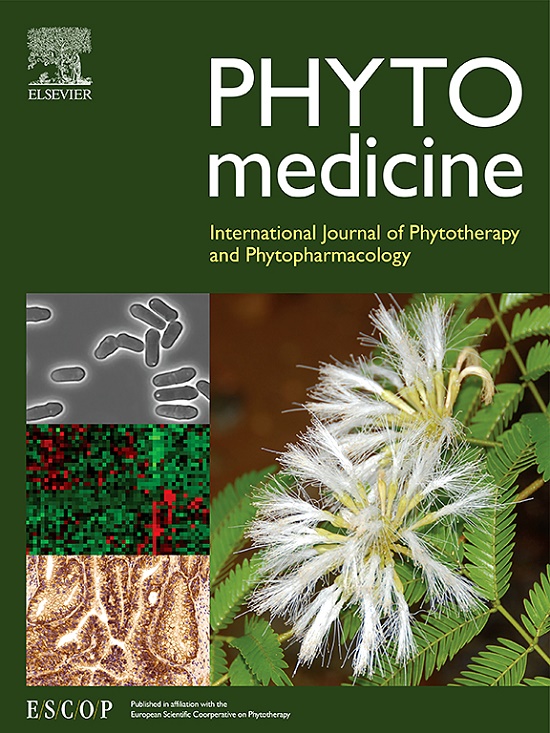Mechanism of Xue-Jie-San treating Crohn's disease complicated by atherosclerosis: Network pharmacology, molecular docking and experimental validation
IF 6.7
1区 医学
Q1 CHEMISTRY, MEDICINAL
引用次数: 0
Abstract
Background
Crohn's disease (CD), as a chronic systemic inflammatory disease, is strongly associated with the development of premature atherosclerosis (AS). Atherosclerotic cardiovascular disease, including coronary heart disease, myocardial infarction and stroke, is a lethal complication of CD. Nowadays, there is a lack of effective monotherapy for CD complicated by AS.
Purpose
To explore the underlying effects and mechanisms of Xue-Jie-San (XJS) on treating CD complicated by AS via network pharmacology and experimental validation.
Methods
The targets of XJS components were obtained from TCMSP, ETCM and PubChem databases as well as the disease genes of CD and AS from GeneCards, DisGeNET and OMIM databases. The core targets were screened out from the drug-disease common targets identified by protein–protein interaction (PPI) network analysis and then analyzed with GO and KEGG enrichment. The interaction between core target and XJS component was detected by molecular docking and molecular dynamics simulation. Subsequently, the core targets were validated via GEO datasets and their biological functions were confirmed in vitro. Nile red staining was used to evaluated lipid accumulation in human umbilical vein endothelial cells (HUVECs) challenged by lipopolysaccharide (LPS) combined with oxidized low-density lipoprotein (ox-LDL). Levels of pro-inflammatory cytokines were examined by enzyme-linked immunosorbent assay. Chemokine CCL2 and CXCL8 were detected by immunofluorescence staining. The activity of the TLR4/Myd88/NF-κB signaling pathway was assessed using Western blot.
Results
In total, 26 common target genes of XJS, CD and AS were found. Among them, 11 core genes were identified by PPI network analysis. The effects of XJS treating CD complicated by AS were mainly mediated by the lipid and atherosclerosis pathway, inflammatory bowel disease pathway and toll-like receptor signaling pathway. Molecular docking and molecular dynamics simulation displayed strong binding affinity between XJS component and the core target. Six core genes including TLR4, IL-1β, TNF, ICAM1, CCL2 and CXCL8 were validated by GEO datasets. In vitro, the effects of XJS on reducing lipid accumulation, secretion of IL-1β, IL6, TNF-α, CCL2 and CXCL8, and the protein expressions of TLR4, Myd88, p-p65 and ICAM1 were verified.
Conclusion
XJS is a potential candidate drug for the treatment of CD complicated by AS. The underlying mechanisms involve mitigation of lipid accumulation-mediated endothelial dysfunction and blockage of immune inflammatory response by targeting TLR4.

雪莲散治疗克罗恩病并发动脉粥样硬化的机制:网络药理学、分子对接和实验验证。
背景:克罗恩病(CD)是一种慢性全身性炎症性疾病,与过早发生动脉粥样硬化(AS)密切相关。动脉粥样硬化性心血管疾病,包括冠心病、心肌梗死和中风,是克罗恩病的致命并发症。目的:通过网络药理学和实验验证,探讨雪蛤散(XJS)治疗 CD 并发 AS 的潜在作用和机制:方法:从TCMSP、ETCM和PubChem数据库中获取雪蛤散成分的靶点,从GeneCards、DisGeNET和OMIM数据库中获取CD和AS的疾病基因。通过蛋白质-蛋白质相互作用(PPI)网络分析从药物-疾病共同靶点中筛选出核心靶点,然后进行GO和KEGG富集分析。通过分子对接和分子动力学模拟检测了核心靶点与 XJS 成分之间的相互作用。随后,通过 GEO 数据集验证了核心靶标,并在体外证实了其生物学功能。利用尼罗红染色法评估了受到脂多糖(LPS)和氧化低密度脂蛋白(ox-LDL)挑战的人脐静脉内皮细胞(HUVECs)的脂质积累情况。酶联免疫吸附试验检测了促炎细胞因子的水平。免疫荧光染色法检测了趋化因子 CCL2 和 CXCL8。用 Western 印迹法评估了 TLR4/Myd88/NF-κB 信号通路的活性:结果:总共发现了 26 个 XJS、CD 和 AS 的共同靶基因。结果:共发现了26个XJS、CD和AS的共同靶基因,其中通过PPI网络分析确定了11个核心基因。XJS治疗CD并发AS的作用主要通过脂质和动脉粥样硬化通路、炎症性肠病通路和收费样受体信号通路介导。分子对接和分子动力学模拟显示,XJS成分与核心靶点有很强的结合亲和力。GEO数据集验证了包括TLR4、IL-1β、TNF、ICAM1、CCL2和CXCL8在内的六个核心基因。体外实验验证了 XJS 对减少脂质蓄积、IL-1β、IL6、TNF-α、CCL2 和 CXCL8 的分泌以及 TLR4、Myd88、p-p65 和 ICAM1 蛋白表达的作用:结论:XJS是治疗CD并发AS的潜在候选药物。结论:XJS 是治疗 CD 并发强直性脊柱炎的潜在候选药物,其基本机制包括通过靶向 TLR4 缓解脂质蓄积介导的内皮功能障碍和阻断免疫炎症反应。
本文章由计算机程序翻译,如有差异,请以英文原文为准。
求助全文
约1分钟内获得全文
求助全文
来源期刊

Phytomedicine
医学-药学
CiteScore
10.30
自引率
5.10%
发文量
670
审稿时长
91 days
期刊介绍:
Phytomedicine is a therapy-oriented journal that publishes innovative studies on the efficacy, safety, quality, and mechanisms of action of specified plant extracts, phytopharmaceuticals, and their isolated constituents. This includes clinical, pharmacological, pharmacokinetic, and toxicological studies of herbal medicinal products, preparations, and purified compounds with defined and consistent quality, ensuring reproducible pharmacological activity. Founded in 1994, Phytomedicine aims to focus and stimulate research in this field and establish internationally accepted scientific standards for pharmacological studies, proof of clinical efficacy, and safety of phytomedicines.
 求助内容:
求助内容: 应助结果提醒方式:
应助结果提醒方式:


